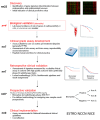Clinical Biomarkers of Tumour Radiosensitivity and Predicting Benefit from Radiotherapy: A Systematic Review
- PMID: 38792019
- PMCID: PMC11119069
- DOI: 10.3390/cancers16101942
Clinical Biomarkers of Tumour Radiosensitivity and Predicting Benefit from Radiotherapy: A Systematic Review
Abstract
Modern advanced radiotherapy techniques have improved the precision and accuracy of radiotherapy delivery, with resulting plans being highly personalised based on individual anatomy. Adaptation for individual tumour biology remains elusive. There is an unmet need for biomarkers of intrinsic radiosensitivity that can predict tumour response to radiation to facilitate individualised decision-making, dosing and treatment planning. Over the last few decades, the use of high throughput molecular biology technologies has led to an explosion of newly discovered cancer biomarkers. Gene expression signatures are now used routinely in clinic to aid decision-making regarding adjuvant systemic therapy. They have great potential as radiotherapy biomarkers. A previous systematic review published in 2015 reported only five studies of signatures evaluated for their ability to predict radiotherapy benefits in clinical cohorts. This updated systematic review encompasses the expanded number of studies reported in the last decade. An additional 27 studies were identified. In total, 22 distinct signatures were recognised (5 pre-2015, 17 post-2015). Seventeen signatures were 'radiosensitivity' signatures and five were breast cancer prognostic signatures aiming to identify patients at an increased risk of local recurrence and therefore were more likely to benefit from adjuvant radiation. Most signatures (15/22) had not progressed beyond the discovery phase of development, with no suitable validated clinical-grade assay for application. Very few signatures (4/17 'radiosensitivity' signatures) had undergone any laboratory-based biological validation of their ability to predict tumour radiosensitivity. No signatures have been assessed prospectively in a phase III biomarker-led trial to date and none are recommended for routine use in clinical guidelines. A phase III prospective evaluation is ongoing for two breast cancer prognostic signatures. The most promising radiosensitivity signature remains the radiosensitivity index (RSI), which is used to calculate a genomic adjusted radiation dose (GARD). There is an ongoing phase II prospective biomarker-led study of RSI/GARD in triple negative breast cancer. The results of these trials are eagerly anticipated over the coming years. Future work in this area should focus on (1) robust biological validation; (2) building biobanks alongside large radiotherapy randomised controlled trials with dose variance (to demonstrate an interaction between radiosensitivity signature and dose); (3) a validation of clinical-grade cost-effective assays that are deliverable within current healthcare infrastructure; and (4) an integration with biomarkers of other determinants of radiation response.
Keywords: biomarker; gene expression signature; radiosensitivity; radiotherapy.
Conflict of interest statement
The authors declare no conflict of interest.
Figures


References
-
- Borras J.M., Lievens Y., Dunscombe P., Coffey M., Malicki J., Corral J., Gasparotto C., Defourny N., Barton M., Verhoeven R., et al. The Optimal Utilization Proportion of External Beam Radiotherapy in European Countries: An ESTRO-HERO Analysis. Radiother. Oncol. 2015;116:38–44. doi: 10.1016/j.radonc.2015.04.018. - DOI - PubMed
Publication types
Grants and funding
LinkOut - more resources
Full Text Sources

